| 版本 | 功能调整 |
| --- | --- |
| 5.0.5 | 原生查询不支持返回数据集对象 |
默认的结果类型是数组
```
'resultset_type' => 'array',
```
### **获取单条数据**
Db类find返回数组
```
$users = \think\Db::name('user')->find(1);
```

返回Model模型对象(这里是User模型对象)
模型对象数据库查出的值在data属性里,
通过__get动态获取字段的值
```
$users1 = model('user')->find(1);
$users2 = model('user')::find(1);
$users3 = model('user')::get(1);
echo $users1->id;
echo $users2->id;
echo $users3->id;
```
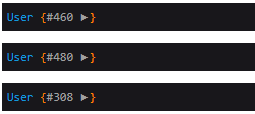
模型对象可以直接使用toArray()转成数组
```
$user1=$users1->toArray()
```

### **获取多条数据**
select和All默认返回模型组成的数组
```
$users1 = \think\Db::name('user')->select();
$users2 = model('user')::all();
$users3 = \app\index\model\User::all();
```
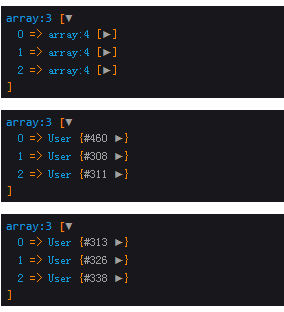
可知select和All在` 'resultset_type' => 'array',`的情况下是无法直接使用toArray的
我们可以将User模型遍历出来在进行toArray()进行转化,第二种办法就是直接将数据转为数据集类在进行toArray()
```
collection($users3)->toArray()
```

### **让select和All默认返回数据集类**
数据库的查询结果也就是数据集,database.php默认的配置下,数据集的类型是一个二维数组,我们可以配置成数据集类,就可以支持对数据集更多的对象化操作,需要使用数据集类功能,可以有以下几种方法
**1、database.php配置数据库的`resultset_type`参数如下:**
~~~
return [
// 数据集返回类型 注意这里的值是全小写的collection,或者`'\think\Collection'`
'resultset_type' => 'collection',
];
~~~
**2、或者在模型中定义resultSetType 属性**
~~~
protected $resultSetType = 'collection';
~~~
**3、V5.1.23+ 版本开始,你可以在查询的时候指定是否需要返回数据集(无需配置 resultset\_type 参数)**
~~~
// 获取数据集
$users = Db::name('user')->fetchCollection()->select();
~~~
配置完成后返回的数据集对象是`think\Collection`,
```
$users1 = \think\Db::name('user')->select();
$users2 = model('user')::all();
$users3 = \app\index\model\User::all();
```
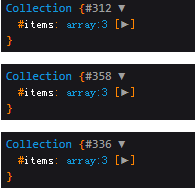
`think\Collection`提供了和数组无差别用法,并且另外封装了一些额外的方法。、
可以直接使用数组的方式操作数据集对象,例如:
~~~
// 获取数据集
$users = \think\Db::name('user')->select();
// 直接操作第一个元素结果直接为数组了哦
$item = $users[0];
dump($item);
// 获取数据集记录数
$count = count($users);//3
// 遍历数据集
foreach($users as $user){
//遍历后的$user也是数组了
echo $user['username'].'<--->';
echo $user['id'].'@<br>';
}
//数据集直接转为数组
$users_arr=$users->toArray();
dump($users_arr);
~~~
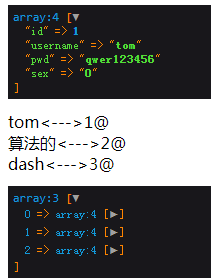
需要注意的是,如果要判断数据集是否为空,不能直接使用`empty`判断,而必须使用数据集对象的`isEmpty`方法判断,例如:
~~~
$users = \think\Db::name('user')->select();
if($users->isEmpty()){
echo '数据集为空';
}
~~~
## **总结:**
>[info]find() 查询结果必为 一维数组
value/column 查询结果必为 int/string/一维数组
select与All 当配置resultset\_type => collection 时, 查询结果为 collection数据集
select 当配置resultset\_type => array时,如果用Db::类查询为二维数组,但如果用Model类查询为Model对象(使用不当会报错,因为它是个对象)可用collection($Model);转为数据集
结论:
Query查询单条数据返回数组,Model查询单条数据返回的模型类可以直接使用toArray()转数组
Query和Model查询多条数据时
## **数据集方法操作**
**Model:**
```
// 获取数据集
$users = model('user')->select();
if ($users instanceof \think\Collection && !$users->isEmpty()) {
//获取全部的数据
dump($users->all());
dump($users->toArray());
}
```
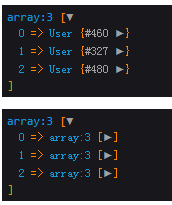
虽然返回的是Model但是还是可以向操作数组那样操作Model里的data属性
```
// 获取数据集
$users = model('user')->select();
$users = model('user')::All();
if ($users instanceof \think\Collection && !$users->isEmpty()) {
//获取全部的数据
dump($users);
dump($users->all());
dump($users->column('id','username'));//column用法和array_column一致
dump($users[0]['username']);
$users[0]['xixi']='haha';
dump($users->toArray());
}
```
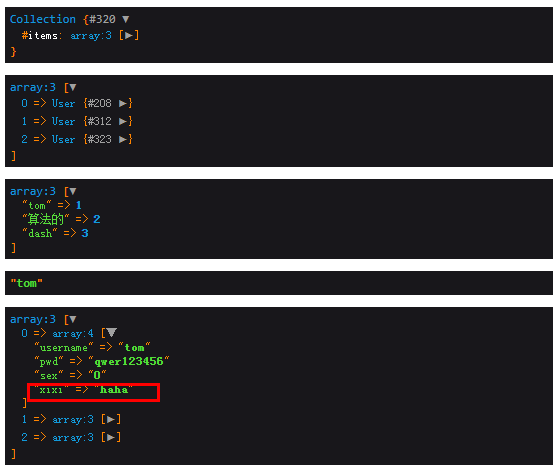

**Query:**
```
// 获取数据集
$users = \think\Db::name('user')->select();
if ($users instanceof \think\Collection && !$users->isEmpty()) {
//获取全部的数据 Query获取多条数据时,同$users->toArray()
dump($users->all());
$newUsers=$users->merge(['name'=>'dash']);
dump($newUsers);
$newUsers=$users->merge([['name'=>'dash','id'=>4,'pwd'=>'123','sex'=>'1']]);
dump($newUsers);
dump($users->all());
dump($newUsers->all());
}
```
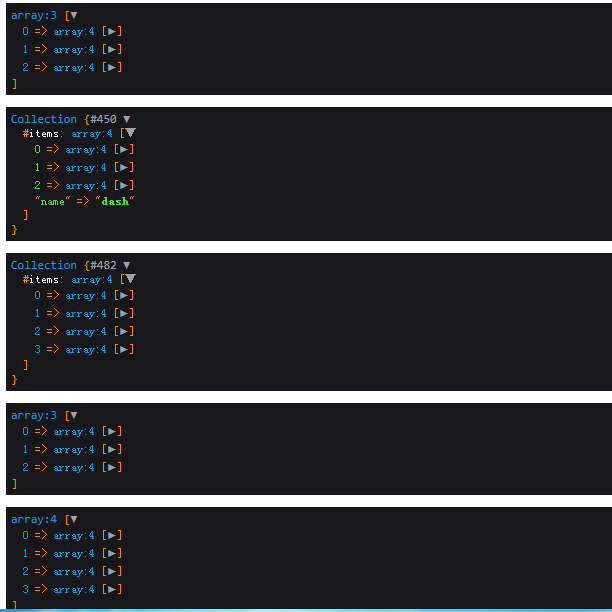
```
// 获取数据集
$users = \think\Db::name('user')->select();
if ($users instanceof \think\Collection && !$users->isEmpty()) {
//获取全部的数据
dump($users->all());
$users->pop();
dump($users->all());
}
```
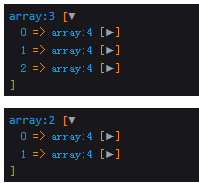
```
// 获取数据集
$users = \think\Db::name('user')->select();
if ($users instanceof \think\Collection && !$users->isEmpty()) {
//获取全部的数据
dump($users->all());
$users->unshift(['name'=>'张三','id'=>4,'pwd'=>'123','sex'=>'1']);
$users->unshift(['name'=>'李四','id'=>5,'pwd'=>'456','sex'=>'1'],"自定义键");
dump($users->all());
}
```
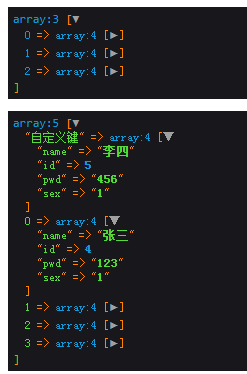
```
// 获取数据集
$users = \think\Db::name('user')->select();
if ($users instanceof \think\Collection && !$users->isEmpty()) {
//获取全部的数据
dump($users->all());
dump($users->column('id'));//column用法和array_column一致
dump($users->column('id','username'));
}
```
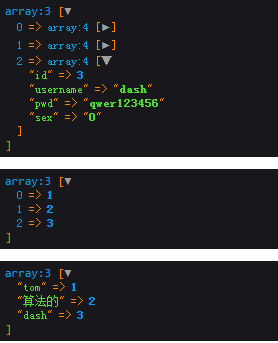
`Collection`类包含了下列主要方法:
| 方法 | 描述 |
| --- | --- |
| isEmpty() | 是否为空 |
| toArray() | 转换为数组 |
| toJson() | 转换为json |
| all() | 所有数据 |
| merge($items) | 合并其它数据 |
| diff($items) | 比较数组,返回差集 |
| flip() | 交换数据中的键和值 |
| intersect($items) | 比较数组,返回交集 |
| keys() | 返回数据中的所有键名 |
| pop() | 删除数据中的最后一个元素 |
| shift() | 删除数据中的第一个元素 |
| unshift($value, $key = null) | 在数据开头插入一个元素 |
| push($value, $key = null)| 在数组结尾插入一个元素 |
| reduce(callable $callback, $initial = null) | 通过使用用户自定义函数,以字符串返回数组 |
| reverse() | 数据倒序重排 |
| chunk($size, $preserveKeys = false) | 数据分隔为多个数据块 |
| each(callable $callback) | 给数据的每个元素执行回调 |
| filter(callable $callback = null) | 用回调函数过滤数据中的元素 |
| column($columnKey, $indexKey = null) | 返回数据中的指定列 |
| sort(callable $callback = null) | 对数据排序 |
| shuffle() | 将数据打乱 |
| slice($offset, $length = null, $preserveKeys = false) | 截取数据中的一部分 |
- 目录结构与基础
- 修改数据后页面无变化
- 防跨目录设置
- input
- 系统目录
- 自动生成的文件以及目录
- 类自动加载
- url生成
- 数据增删改查
- 增加数据
- 数据更新
- 数据删除
- 数据查询
- 架构
- 生命周期
- 入口文件
- URL访问规则
- 配置
- 默认惯例配置配置
- 初始应用配置
- 路由
- 域名路由
- URL生成
- 数据库操作
- 方法列表
- 连接数据库
- 分布式数据库
- 查询构造器
- 查询数据
- 添加数据
- 更新数据
- 删除数据
- 查询语法
- 聚合查询(统计)
- 时间查询
- 高级查询
- 视图查询
- 子查询
- 辅助查询之链式操作
- where
- table
- alias
- field
- order
- limit
- page
- group
- having
- join
- union
- distinct
- lock
- cache
- comment
- fetchSql
- force
- bind
- partition
- strict
- failException
- sequence(pgsql专用)
- 查询事件
- 事务操作
- 监听SQL
- 存储过程
- 数据集
- 控制器
- 跳转和重定向
- 空控制器和空操作
- 分层控制器
- Rest控制器
- 资源控制器
- 自动定位控制器
- tp3的增删改查
- 方法注入
- 模型
- 属性方法一览
- 类方法详解
- Model
- 调用model不存在的属性
- 调用model中不存在的方法
- 调用model中不存在的静态方法
- hasOne
- belongsTo
- hasMany {Relation}
- belongsToMany
- hasManyThrough
- morphMany
- morphOne
- morphTo
- ::hasWhere {Query}
- ::has
- relationCount
- data 【model】
- setInc {integer|true}
- setDec {integer|true}
- save {integer | false}
- saveAll {array}
- delete {integer}
- ::get 查询单条数据 {Model}
- ::all 查询多条数据{Model [ ]}
- ::create 新增单条数据 {Model}
- ::update 更新单条数据 {Model}
- ::destroy {integer}
- ::scope {Query}
- getAttr {mixed}
- xxx
- append
- appendRelationAttr
- hidden
- visible
- except
- readonly
- auto
- together
- allowField
- isUpdate
- validate
- toCollection
- toJson
- toArray
- 定义
- 新增
- 更新
- 查询
- 删除
- 聚合
- 获取器
- 修改器
- 时间戳
- 只读字段
- 软删除
- 类型转换
- 数据完成
- 查询范围
- 模型分层
- 数组访问和转换
- JSON序列化
- 事件
- 关联
- 一对一关联
- 主表一对一关联
- 从表一对一关联(相对关联)
- 一对多关联
- 主表定义一对多关联
- 从表定义一对多关联
- 远程一对多
- 多对多关联
- 多态关联
- 动态属性
- 关联预载入with()
- 关联统计
- N+1查询
- 聚合模型
- Model方法集合
- 表单验证
- 验证器
- 验证规则
- 错误信息
- 验证场景
- 控制器验证
- 模型验证
- 内置规则
- 静态调用
- 表单令牌
- Token身份令牌
- 视图
- 模版
- 变量输出
- 函数输出
- Request请求参数
- 模板注释及原样输出
- 三元运算
- 内置标签
- 模板继承
- 模板布局
- 日志
- 日志初始化
- 日志驱动
- 日志写入
- 独立日志
- 日志清空
- 写入授权
- 自定义日志
- 错误和调试
- 异常
- php系统异常及thinkphp5异常机制
- 异常处理
- 抛出异常
- 异常封装
- resful
- 404页面
- 调试模式
- Trace调试
- SQL调试
- 变量调试
- 性能调试
- 远程调试
- 安全
- 输入安全
- 数据库安全
- 上传安全
- 其它安全建议
- xss过滤
- 扩展
- 函数
- 类库
- 行为
- 驱动
- Composer包
- Time
- 数据库迁移工具
- Workerman
- MongoDb
- htmlpurifier XSS过滤
- 新浪SAE
- oauth2.0
- 命令行及生成文件
- 系统现成命令
- 创建类库文件
- 生成类库映射文件
- 生成路由缓存
- 清除缓存文件
- 生成配置缓存文件
- 生成数据表字段缓存
- 自定义命令行
- 开始
- 调用命令
- 杂项
- 助手函数
- URL重写
- 缓存
- 缓存总结
- Session
- Cookie
- 多语言
- 分页
- 上传
- 验证码
- 图像处理
- 文件处理
- 单元测试
- 自定义表单令牌
